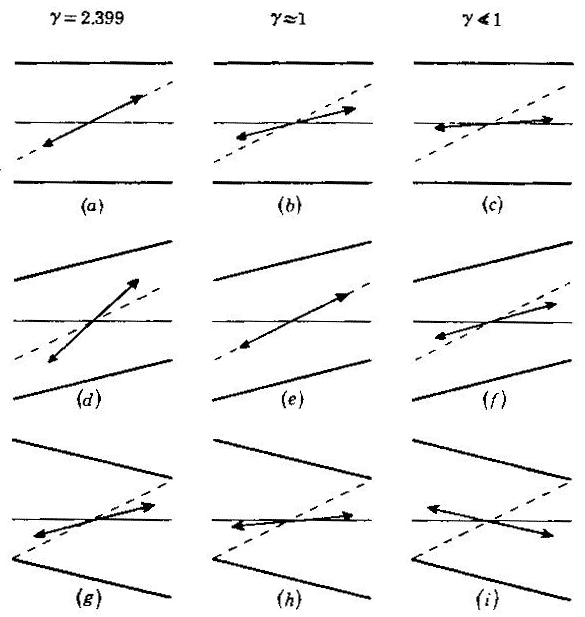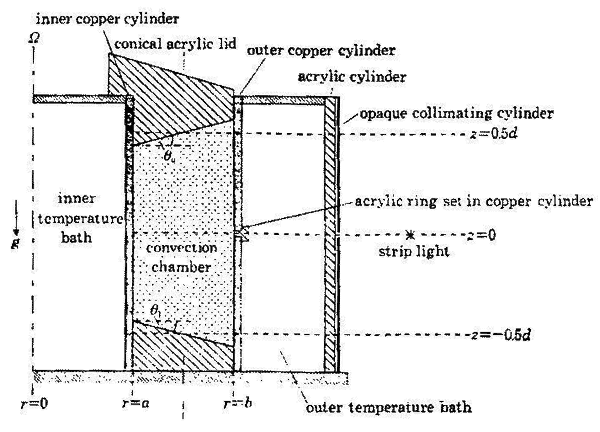Tutorial 1.3
Baroclinic annulus flows with sloping boundaries
The presence of boundaries at the top and bottom of the channel which are inclined in the radial direction may have some important modifying effects on baroclinic wave flows. This is partly because flow adjacent to a radially sloping boundary will tend to be forced towards a trajectory in the meridional plane moving parallel with the slope – which may affect the ability of fluid parcels to release potential energy within the baroclinic ‘wedge of instability’. This may be seen more clearly in the figure below for cases where the upper and lower boundary slope in the opposite sense.

The diagram above illustrates the energetics of baroclinic instability with parallel sloping upper and lower boundaries. Thick solid lines show the upper and lower boundaries, thin solid lines the geopotentials, dashed lines indicate isotherms or isopycnals and arrows indicate the angle of parcel interchange (after Mason 1975).
The effect is shown most clearly in the leftmost column, which corresponds to the situation of marginal baroclinic instability. In this case, with horizontal endwalls the preferred trajectory for parcel interchange is parallel with the isotherms – which releases no potential energy and so is a state of neutral stability.
- With endwalls sloping in the same sense as the isotherms or isopycnals, parcel interchange is constrained to slope more steeply than before (with horizontal boundaries). This actually requires increased potential energy to interchange fluid parcels, implying a positively stable condition for baroclinic instability.
- With endwalls which slope in the opposite sense to the isotherms or isopycnals, the preferred trajectory for parcel interchange is less steep than for horizontal boundaries. This actually forces the slope of the interchange trajectory into the ‘wedge of instability’, allowing the spontaneous release of potential energy. The result is that the flow is destabilised and growth of baroclinic waves is enhanced.
The other main effect of sloping boundaries may be to introduce a form of ‘planetary vorticity gradient’. If the upper and lower boundaries slope at different angles, the depth of the annulus becomes a function of radius. Such a variation can be shown to be directly equivalent to a planetary ‘beta effect’ in the case of purely barotropic flow. In that case, azimuthally travelling waves will become dispersive and behave like Rossby waves in the atmosphere or oceans. For baroclinic flows, however, this analogy is more complicated, and effects may be a mixture of both beta effects and changes to the baroclinic stability characteristics of the flow.
These effects can be illustrated in laboratory experiments – a schematic arrangement is shown below:

In the following clips you can observe the effects of variously sloping boundaries on annulus flows, conducted at two different rotation rates, \(\Omega = 1.5\text{ rad s}^{-1}\) and \(3.0\text{ rad s}^{-1}\). The experiments took place at the Geophysical Fluid Dynamics laboratory (known as Met O 21) at the UK's Met Office, with the clips digitised by Oxford Physics in June 2006. Click on the title of a video for a larger display (opens in a new YouTube tab), with detailed information about each individual clip.
Group 1: \(\Omega=1.5\text{ rad s}^{-1}\)
- \(\theta_u=\theta_l=0°\) (no slope): \(m=4\)
https://youtu.be/TVppTmXDdEc - \(\theta_u=\theta_l=+24°\) (upward slope, perpendicular to isotherms): \(m=5\)
https://youtu.be/3rZpIS9SFX4 - \(\theta_u=\theta_l=+24°\) (upward slope, parallel to isotherms): \(m=2AV\)
https://youtu.be/AOLhhfaHf78 - \(\theta_u=\theta_l=-24°\) (upward slope, parallel to isotherms): \(m=3\)
https://youtu.be/5DCspn7hY5M
Group 2: \(\Omega=3.0\text{ rad s}^{-1}\)
- \(\theta_u=\theta_l=0°\) (no slope): \(m=4\)
https://youtu.be/qa6EhcRIWng - \(\theta_u=\theta_l=+24°\) (upward slope, perpendicular to isotherms): \(m=\text{irregular (12?)}\)
https://youtu.be/4lx2Ap7LuSI - \(\theta_u=\theta_l=+24°\) (upward slope, parallel to isotherms): \(m=3AV\)
https://youtu.be/Q40xCcA0A68 - \(\theta_u=\theta_l=-24°\) (upward slope, parallel to isotherms): \(m=\text{irregular (dispersive)}\)
https://youtu.be/aT4bJe-qnvw
